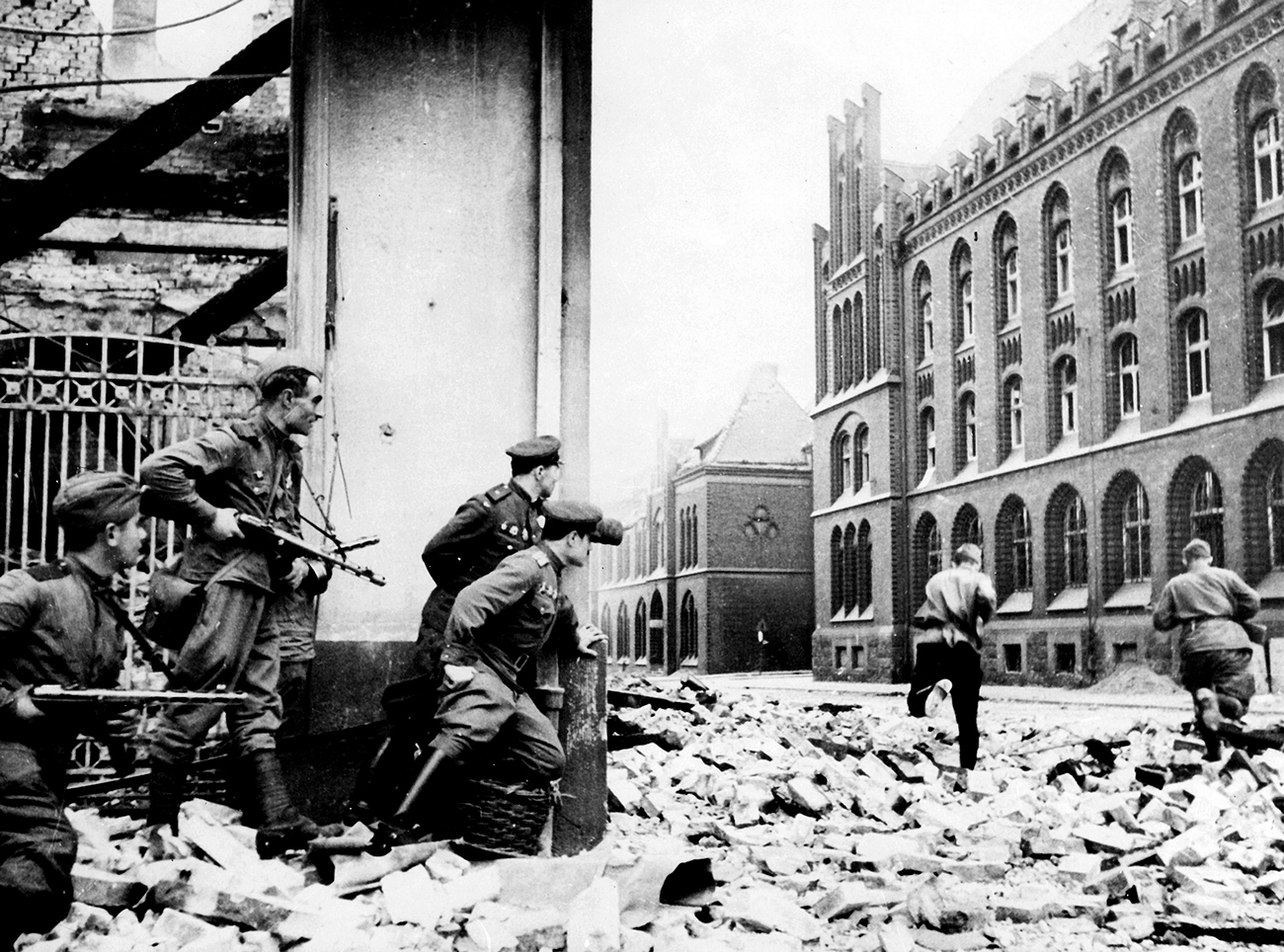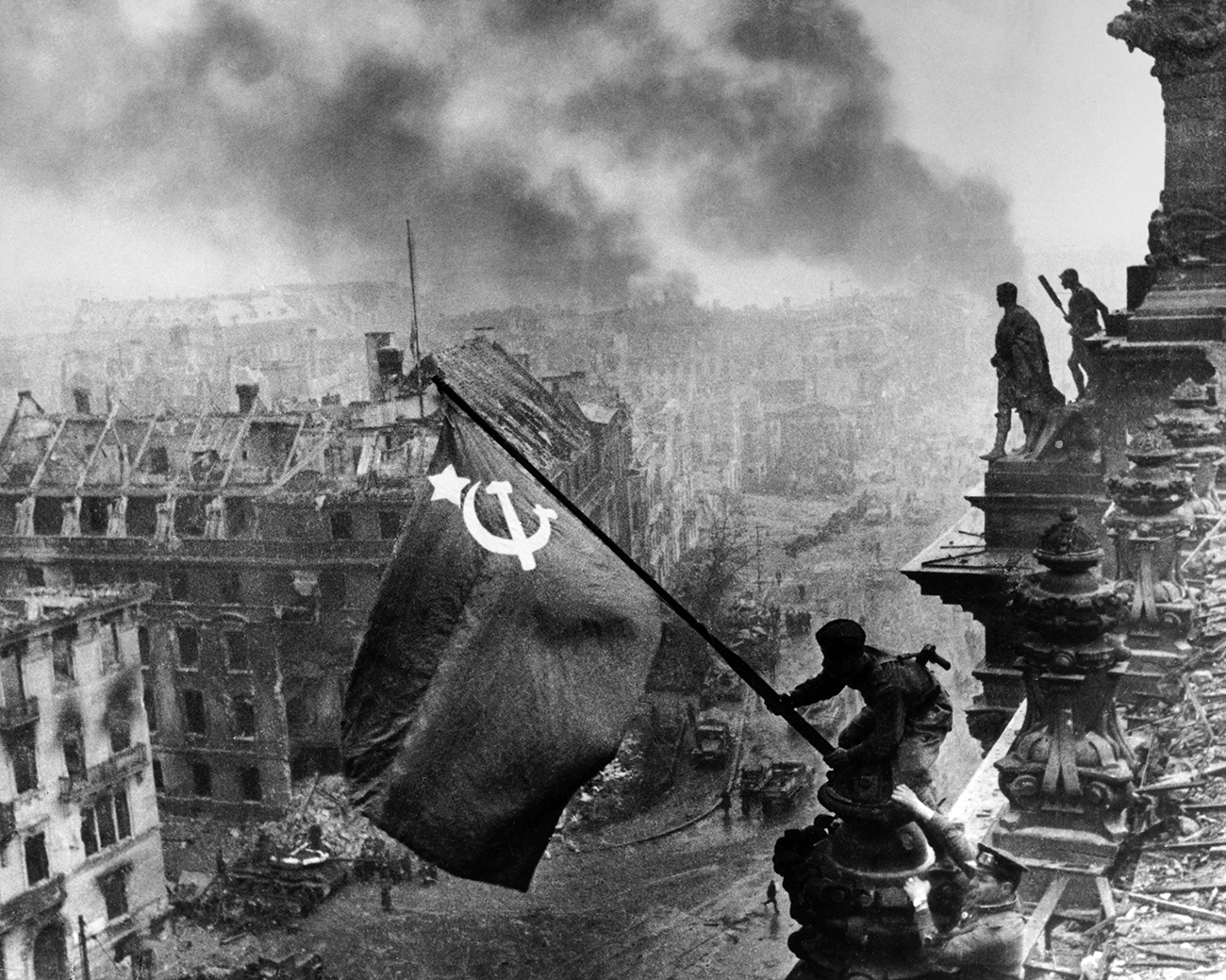Where Was the First Battle of the Revolutionary War
 The Red Army in the streets of Berlin, April 1945. / Pic: DPA/Global Look Agitat
The Red Army in the streets of Berlin, April 1945. / Pic: DPA/Global Look Agitat
The Fight of Berlin was one of the largest battles in human history. It began on April 16 in the outskirts of the city. By April 25, Soviet military personnel had entered the Nazi Germany's capital. About 3.5 zillion soldiers from both sides participated in the fight with more than than 50,000 weapons and 10,000 tanks.
Why didn ' t the other Allied forces fight in Irving Berlin?
State troops stormed Berlin while the rest of the Confederative army remained more than 100 kilometers inaccurate the Berlin. In 1943, U.S. President F. D. Roosevelt declared that "the U.S. must obtain Berlin." British Prime Minister Winston First Duke of Marlborough agreed that the Nazi capital mustiness not fall into State hands. Nonetheless, in the spring of 1945, these Alignment forces did non make any cause to take self-command of the metropolis. British historian John Fuller known as information technology "one of the strangest decisions ever successful in military history."
 Yalta Conference 1945: Churchill, Stalin, Roosevelt. / Exposure: Public domain
Yalta Conference 1945: Churchill, Stalin, Roosevelt. / Exposure: Public domain
Still, this decision had its motives. In an interview with RBTH, Russian historiographer Andrei Soyustov aforementioned that there were at least ii reasons for this decision. Forward, according to preliminary agreements, including the accords made in Yalta, Berlin was located in the zone of Soviet military operations. The demarcation line between the USSR and the other Allied forces went along the Elbe River. "Rushing into Berlin for the sake of status, could have, at minimum, backfired and whitethorn have resulted in a USSR decision not to fight against Japan," explains the historiographer. The second reason for non storming the elephantine urban center was that the Allies had been full with casualties American Samoa the terminate of the warfare approached. In the period between the Normandy landing and April 1945 the Allies "were able to avoid storming large cities," Soyustov notes.
Soviet casualties in the Battle of German capital were so very lofty with 80,000 impaired and at least 20,000 killed. The High German lateral suffered just arsenic many losses.
A Night attack under floodlights
Berlin was captured by Soviet troops on iii fronts. The most tall task fell to the soldiers from the First Belarus Front, commanded by Georgy Zhukov, who had to charge the swell-fortified German position in Seelow Heights on the outskirts of the city. The attack began during the night of April 16 with an unprecedentedly powerful and coordinated artillery bombardment. Then, without waiting for morning, tanks entered the battle supported by the foot. The offensive was conducted with the help of floodlights, which were set up behind the advancing troops. Equal with the use of this clever this tactic, some days were necessary to seize Seelow Heights.
 Soviet artillery at the Seelow Heights, April 1945. / Pic: Getty Images
Soviet artillery at the Seelow Heights, April 1945. / Pic: Getty Images
At the start, near peerless million High German servicemen were concentrated around Berlin. However, they were met by a Soviet ram that was 2.5 times greater. At the very beginning of the Berlin operation, Soviet troops succeeded in cut the majority of the German units from the City. Out-of-pocket to this, the Land Army encountered only a few hundred thousand German soldiers in Berlin itself, including the Volkssturm (the militia) and the Hitler Youth. There were as wel many United States Secret Service units from different European countries.
All bets on the tanks
Adolf Hitler's soldiery worked desperately to defend themselves with ii lines of defence reaction unionized in Berlin. Many homes were armed with bunkers and these houses, with their syrupy walls, became impregnable strongholds. Of particular danger for the forward Soviet soldiery were the anti-tank weapons, bazookas and hand grenades since Soviet forces were heavily reliant on the use of armored vehicles during the attack. In this environment of urban warfare, many tanks were destroyed.
 Soviet combat troops en route to the center of German capital, 1945. / Photograph: Arkadyi Shaikhet/RIA Novosti
Soviet combat troops en route to the center of German capital, 1945. / Photograph: Arkadyi Shaikhet/RIA Novosti
Following the war, commanders of the Soviet operation were oft criticized for relying so heavily along the use of armor-clad vehicles. However, every bit emphasized past Soyustov, in so much conditions the use of tanks was justified. "Thanks to the heavy use of armored vehicles, the Soviet army was able to create a very mobile unit of measurement of support for the advancing soldiery, which helped them erupt through the barricades into the city centre."
The manoeuvre used in the Battle of Berlin built connected experience from the Battle of Stalingrad. The Soviet troops recognized special Assault units, in which tanks played a discerning role. Typically, maneuvers were carried out in the following manner: The foot moved along some sides of the street, checking the windows on both sides, to name obstacles that were dangerous for the vehicles, such as camouflaged weapons, barricades and tanks embedded in the ground. If the troops noticed such impediments raised up, the Land infantry would delay for the arriver of their automotive tanks and self-propelled howitzers, titled "Stalin's sledgehammer." Once this support arrived, the armored vehicles would run to destroy German fortifications at point-blank range. However, there were situations where the infantry could not retain up with the armored vehicles and accordingly, the tanks were isolated from their cover and became easy fair gam for the German anti-tank car weapons and artillery unit.
The capture of the Reichstag
The culmination of the offensive on Berlin was the battle for the Reichstag, the German parliament building. At the time, it was the highest building in the city centre and its capture had symbolic meaning. The first endeavour to seize the Reichstag on April 27 failed and the engagement continuing for quaternion more days. The watershed occurred on April 29 as Soviet troops took monomania of the fortified Interior Ministry building, which occupied an entire block. The Soviets finally captured the Reichstag along the eve of April 30.
 Victory Banner over the Reichstag, 1945. / Photo: Multimedia Art Museum Moscow
Victory Banner over the Reichstag, 1945. / Photo: Multimedia Art Museum Moscow
Early in the morning of Crataegus laevigata 1, the flag of the 150th Reave division was raised over the building. This was later referred to as the Banner of Victory.
On April 30, Hitler committed felo-de-se in his bunker. Until the worst bit, Hitler had been hoping that military personnel from other parts of Deutschland would concern his attention in Berlin, but this did not happen. The Israel Baline soldiery surrendered on May 2.
Was the Battle of Berlin necessary?
Calculating the losings involved in the Battle of German capital at the end of much a bloody war, some historians doubt whether the Soviet onslaught of the City was obligatory. In the opinion of historian and author Yuri Zhukov, after the Soviet and Dry land troops met at the Elbe river, circumferent the German units in Berlin, it was possible to do without the offensive on the Nazi upper-case letter. "Georgy Zhukov… could have sporting demanding the blockade circle on an hourly basis… But for an entire week, he mercilessly sacrificed thousands of Soviet soldiers… He obtained the surrender of the Berlin garrison along May 2. But if this capitulation had occurred not happening May 2 but, permit's aver, on the 6th or the 7th, tens of thousands of our soldiers would have been saved," Zhukov continues.
 Berlin, the Last Day War II. / Photo: Circular Look Press
Berlin, the Last Day War II. / Photo: Circular Look Press
Notwithstandin, in that respect are other opinions that contradict this opinion. Some researchers say that if the Land troops had just enclosed the City, they would possess missed the strategic initiative to the Germans. Nazi attempts to break the blockade from the inside and outside would have resulted in just atomic number 3 many losses for the Country Army as the approach, claims Soyustov. Information technology is besides not transparent how long much a blockade would have lasted.
Soyustov too says that delaying the Berlin operation could have resulted in opinion problems between the Confederate forces. It is no secret that towards the end of the state of war the Third Reich's representatives tried to negotiate a separate peace treaty deal with the Americans and British forces. "In these circumstances, no ace would wealthy person been able to predict how a blockade of Irving Berlin would have developed," Soyustov is convinced.
Read more: Fin questions all but the judgment at Nurnberg
If using any of Russia Beyond's content, partly or in full, always cater an operational hyperlink to the master copy material.
Receive the week's best stories straight to your inbox
Where Was the First Battle of the Revolutionary War
Source: https://www.rbth.com/arts/history/2017/04/25/how-the-russians-took-berlin-single-handedly_749878
0 Response to "Where Was the First Battle of the Revolutionary War"
Post a Comment